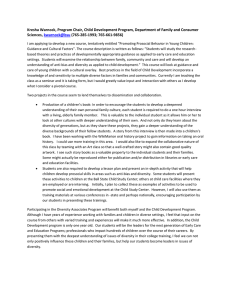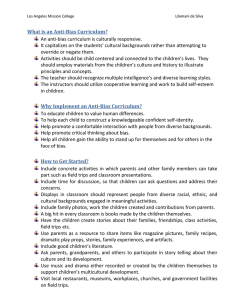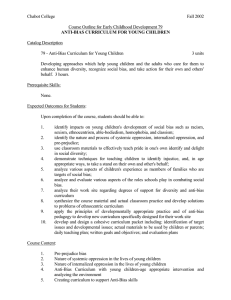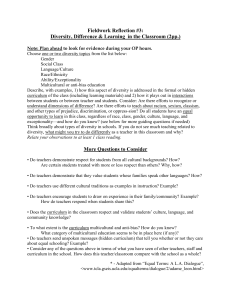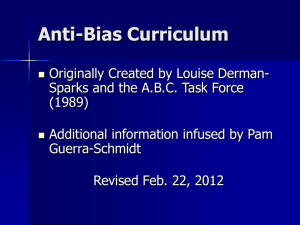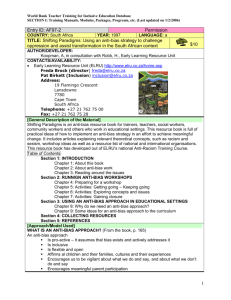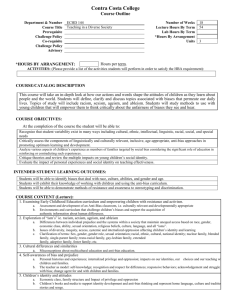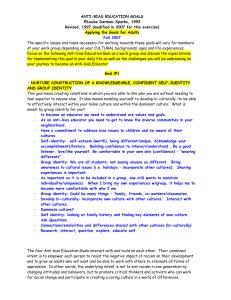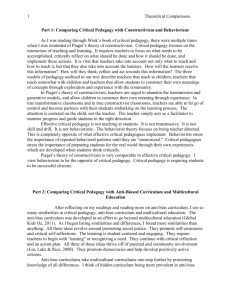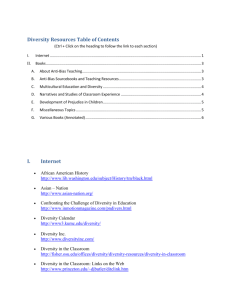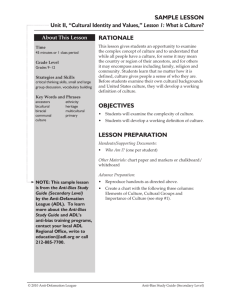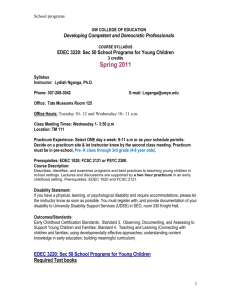叁、河濱街(Bank Street) 教育模式
advertisement
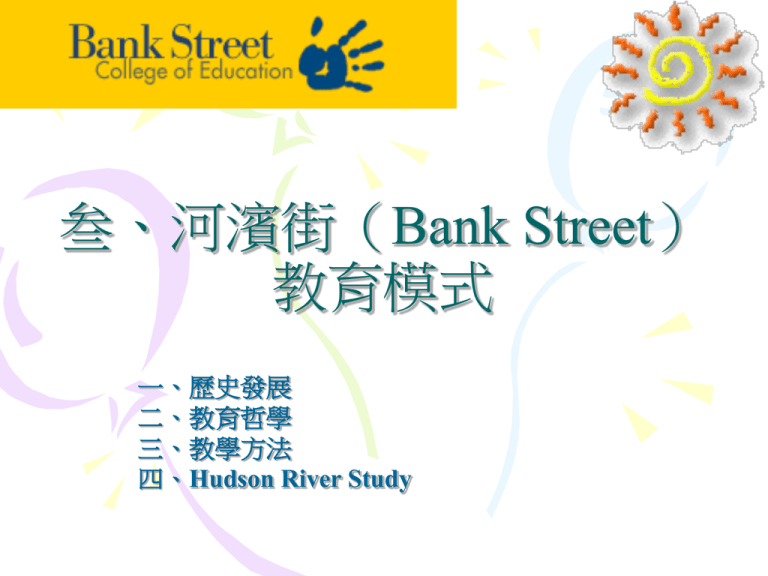
叁、河濱街(Bank Street) 教育模式 一、歷史發展 二、教育哲學 三、教學方法 四、Hudson River Study 一、河濱街教育模式的歷史發展(1) 1. 1916-1920s: (1) 1916年,創立者Lucy Sprague Mitchell不滿於當時公立教育將孩 童教育集中在擁擠的學習空間,故發展出適宜發揮兒童潛能的教 育環境之教育模式。 (2) 1916年,教育實驗處(Bureau of Educational Experiments)成立, 此為河濱街教育學院(Bank Street College of Education)的前身。 Lucy Mitchell開始著力於實驗學校兒童發展之研究,並聘請了醫生、 社工人員以及其他專業人員擔任教師。 (3) 1921年,Mitchell出版了第一本河濱街教育刊物:《Here and Now Storybook》,目的在改善兒童的文字素養能力,後成為兒童 主要的教科書。(The Brief History of Bank Street College of Education, 2008) 一、河濱街教育模式的歷史發展(2) 2. 1930s-1970s: (1) 此時期的河濱街教育模式因應當時美國起頭計畫(Head Start Programme)。1965年,美國通過「人權法案」(Civil Rights Act of 1965),河濱街教育學院配合人權法案支持下的起頭計畫而建立諸 多工作小組。例如建立全美第一個起頭計畫方案(Head Start Programme):“第42街學前兒童起頭模式培訓中心”(42nd Street Early Childhood Model Head Start Training Center),使得河濱街研 究部門成為美國國家的研究中心。 (2) 從1968到1981年之間,河濱街教育學院成為美國聯邦政府支持下 的單位之一(Federal Follow Through Programme ),主要為經濟地 位不利者的(economically disadvantaged)小學教育提供資助。 一、河濱街教育模式的歷史發展(2):補充 說明(1965年起頭計劃) • 計畫背景:Head Start於1965首次由 Office of Economic Opportunity 推出,後轉交至現時的衛生福利部門 (Department of Health & Human Services)管轄;於1994年更 發展出專為孕婦及嬰兒而設Early Head Start計劃 • 計畫目標:為兒童,特別是來自貧困家庭者,提供學前服務, 加強他們入學的適應; 透過全面的支援服務,滅少跨代貧窮 的循環。 • 服務對象:懷孕期至5歲之兒童及其家庭 • 負責部門:衛生福利部門下的Head Start Bureau • 主要工作:提供全面及具質素的服務,以培育低收入家庭兒 童的健康發展; - 舉辦教育、早期幼兒發展、醫療、牙齒保健、精神健康、營 養等範疇的不同活動,並邀請家長參與。 • http://www.nhsa.org/ 一、河濱街教育模式的 歷史發展(3) 3.1970-至今:河濱街教育學院離開河濱街… (1) (2) (3) (4) (5) 1970年:河濱街教育學院的原址(Fleishman’s Yeast Building)已不敷 師生人數使用,遂搬遷該處轉移至曼哈頓。 1971年:河濱街教育模式正式更名為「發展-互動模式」 (Developmental- Interaction Approach),課程形式不再以老師的實 務為引導,而是根據概念化與系統化的課程來引導學生,以對抗當時 的行為學派和認知學派對“認知”的發展。 1972年:New Perspectives Programme設立,吸引諸多學生前來河濱街 教育學院學習,進行為期1-2週學前或初等教育培訓課程的學習。 1976年:河濱街教育學院成立博物館研究所課程,開始培養具有博物 館實務經驗與教育知識的專業人才。 1980年代至今:河濱街教育學院陸續發展資訊教育課程。 河濱街教育網址:http://www.bankstreet.edu/gems/about/ABriefHistory.pdf 河濱街模式 的教育哲學 河濱街教育模式的理論基礎 • • • • 心理動力學理論: Freud, Erikson 發展心理學理論: Piaget, Werner 教育理論: Dewey, L. Mitchell等人 河濱街教育模式六個原則: • 1. 發展不是量的變化,而是質的轉變。 • 2. 個人的發展不是固定在發展線上的某一點,而是在一可能的範圍內進 行變化。 • 3. 發展的過程包括穩定與不穩定性。 • 4. 幼兒隨著年齡的增長,其與外界互動的動機越強烈,形式也越多。 • 5. 幼兒的自我概念係來自於他與別人或別的事物互動後的經驗。 • 6. 成長過程中充滿衝突。 河濱街教育模式的目標 • 提升能力 • 獨立個體的認同(identity) • 社會化 • 創造力 • 統整性 河濱街模式的教育哲學:互動取向(Interactive Approach)的發展觀 • 1. Development involves shifts in the way a person organizes experience and copes with the world, generally moving from simpler to more complex, from single to multiple and integrated ways of responding. • 2. Individuals function within a range of possibilities; their development cannot be fixed on a straight line or plane of growth. • 3. Developmental progress involves a mix of stability and instability. Educators seek to find the balance between helping a child consolidate new understandings while offering challenges to promote growth. 河濱街模式的教育哲學:互動取向 (Interactive Approach)的發展觀 • 4. Children's natural curiosity about themselves and the world around them is the motivating force for their learning and their ability to create meaning. • 5. The child's sense of self is constructed from experiences in the physical and social world. This knowledge of self is based on repeated awareness and testing of these interactions. • 6. Growth and maturation involve conflict from within the self and with others. Conflict is necessary for development. How conflicts are resolved depend on the interactions among the unique nature of the child, the significant people in the child's life, and the demands of the culture. 河濱街教育模式的方法 • 環境的規劃: 1. 兼顧個人活動與社會活動的需求。 2. 教室的界線甚為清楚,角落功能分明。 • 教材: 1. 以提供幼兒主動探索及表徵用途的教材。 • 教師的角色: • Biber認為,在認知發展方面,教師的角色有: • (1) 評量幼兒的思考,在控制下引導幼兒的精熟程度。 • (2)對幼兒的反應,給予口頭上的回應或澄清。 • (3)培養幼兒直覺且聯結性的思考。 • (4)提出問題以提升幼兒的歸納性思考。 河濱街教育模式的課程理論與實務 • 識字能力(literacy)課程: • communication and expression about self, others, and the physical world; • appreciation of other points of view; • acquisition of a sense of story; • making the connection between the spoken and the written word; • interest in and use of symbolic representation (e.g., drawing, numbers, letters, sounds, print) 河濱街教育模式的課程理論與實務 • • • • • • 數學課程的教學目標 numerical relations, counting, ordering; one-to-one correspondence; measurement; patterns; geometric understandings about space, volume, and shape; • estimation; • sorting and classifying; • pictorial representation of data. 消弭偏見(anti-bias)的課程 • What is an Anti-Bias Approach? 1. A proactive means to eradicate social oppression with the ultimate goal of social justice in mind 2. A tool of resistance and empowerment 3. An activist approach that challenges -isms Anti-Bias Curriculum: Terms Anti-Bias Curriculum Phase I 1. Raising awareness of own bias 2. Inquire about children’s biases 3. Evaluate environment Anti-Bias Curriculum • Discard materials with stereotypes • Counteract dominant cultural messages with images that challenge stereotypes • Infuse the environment with real artifacts from cultures relevant to community and beyond • Celebrate holidays relevant to cultures represented in community and beyond Anti-Bias Curriculum Phase II 1. Responding to “teachable moments” 2. Teacher-initiated activities 3. Involve parents Anti-Bias Curriculum Noticing similarities and differences regarding: • Skin color • Gender • Hair • Families • Abilities • Class • Belief systems • Age • Size Anti-Bias Curriculum Phase III 1. Creating a culturallyrelevant curriculum 河濱街教育模式的課程理論與實務: Project Promise: A New Path for Prospective Educators • http://www.edutopia.org/projectpromise 河濱街教育學院附小(Schools for Children)簡介 • Experiential education • Constructivism • Ownership of learning 河濱街教育學院附小 (Schools for Children) 簡介 • 1. Lower School The Lower School consists of five classrooms on the second floor: one 3's class, two 4/5's classes, and two 5/6's classes. • 2. Middle School The Middle School consists of eight classrooms, located on the second and third floors, with two classrooms for each age group: 6/7's, 7/8's, 8/9's, and 9/10's. Children in the Middle School benefit from specialist teachers in woodworking, art, music, drama, physical education, Spanish, and, in the oldest groups, math specialists. • 3. Upper School • The Upper School consists of eight classrooms, located on the third and fourth floors, for students aged 10 through 13. Each Upper School classroom is team taught by one teacher for the humanities (social studies and language arts) and one for math and science. Classes are often taught in small groups. 河濱街教育學院附小(School for Children)案 例:Hudson River Study • • • • • • • 討論導引研究方向 出外參觀與相關教學 拜訪九十六街河堤旁 參觀波浪丘陵 拜訪海上警察 參觀水族館 參觀環保工作船(Clear Water Boat) 河濱街教育學院附小案例:Hudson River Study • 以環保教育為例: • http://vimeo.com/3767809
